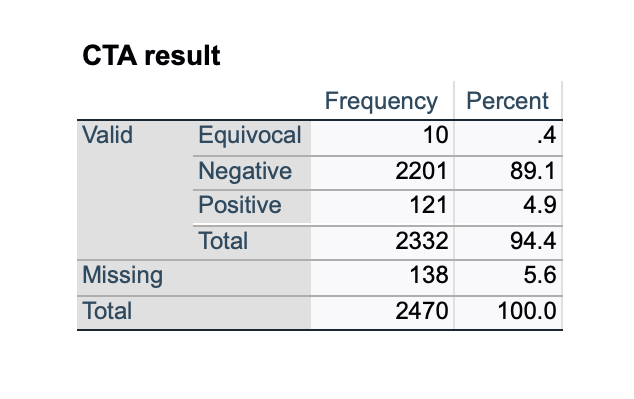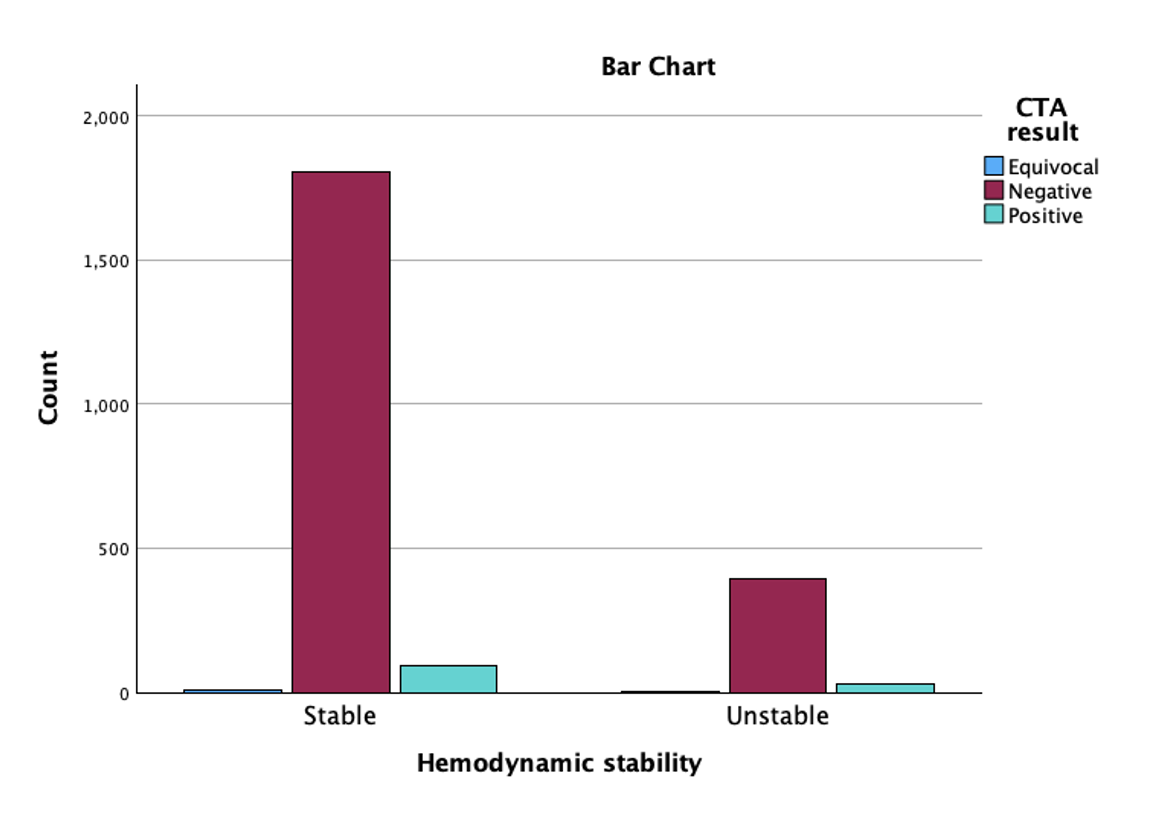Monday Poster Session
Category: GI Bleeding
P3054 - Low Diagnostic Yield and High Cost of CT Angiography in Hemodynamically Stable Patients With Suspected GI Bleeding: A Five-Year Single-Center Retrospective Study
Monday, October 27, 2025
10:30 AM - 4:00 PM PDT
Location: Exhibit Hall
- TT
Temitope Tobun, MD (she/her/hers)
Morehouse School of Medicine
Atlanta, GA
Presenting Author(s)
Temitope Tobun, MD1, Abisola Ajayi, MBBS1, Ayomide F. Sowemimo, MSc, MD1, Ridwan Azees, MD2, Pius E. Ojemolon, MBBS3, Nikrad Shahnavaz, MD4
1Morehouse School of Medicine, Atlanta, GA; 2Morehouse School of Medicine, Oklahoma City, OK; 3Emory University School of Medicine, Atlanta, GA; 4Emory University, Atlanta, GA
Introduction: CT angiography (CTA) is widely used in evaluating acute gastrointestinal (GI) bleeding, but its diagnostic utility in hemodynamically stable patients remains unclear. Overuse may lead to unnecessary radiation, contrast exposure, and increased healthcare costs.
Methods: We performed a retrospective review of patients admitted to Grady Memorial Hospital with suspected GI bleeding who underwent CTA between January 1, 2019, and January 1, 2024. Data collected included CTA results, hemodynamic status on admission, clinical indication, endoscopic findings, interventional radiology (IR) embolization, and outcomes. CTA was considered positive if active GI bleeding was identified. Hemodynamic stability was defined as systolic blood pressure ≥90 mmHg, diastolic blood pressure ≥60 mmHg, and heart rate < 100 bpm. Statistical analysis was performed using IBM SPSS Statistics. Institutional Review Board approval was obtained.
Results: Of 2,470 CTAs identified, 2,332 with complete outcome data were included. CTA results were negative in 2,201 (89.1%), positive in 121 (5.2%), and equivocal in 10 (0.4%). Studies were excluded for incompleteness, duplication, or early termination (5.6%). Positive CTA findings were significantly associated with IR embolization (41.3% vs. 2.0% in negative studies, p < .001), though some embolization’s were for hepatic or splenic artery pseudoaneurysms secondary to trauma. Most patients (n = 1,806) were hemodynamically stable, with a CTA positivity rate of 4.8% compared to 7.0% in unstable patients; a difference that was not statistically significant. No correlation was found between clinical indication and CTA positivity.
Discussion: CTA has limited diagnostic yield in hemodynamically stable patients with suspected GI bleeding. With an estimated cost of $8,409 per scan, over $18 million may have been spent on negative CTAs during the study period. These findings support the need for a risk stratification tool to improve patient selection and reduce unnecessary imaging and cost. This abstract was prepared with assistance from an artificial intelligence language model to improve clarity, grammar, and language structure. All clinical content, data analysis, and interpretations were developed by the authors.

Figure: Table 1. CTA Result

Figure: Figure 1. Hemodynamic Stability and CTA Results
Disclosures:
Temitope Tobun indicated no relevant financial relationships.
Abisola Ajayi indicated no relevant financial relationships.
Ayomide Sowemimo indicated no relevant financial relationships.
Ridwan Azees indicated no relevant financial relationships.
Pius Ojemolon indicated no relevant financial relationships.
Nikrad Shahnavaz indicated no relevant financial relationships.
Temitope Tobun, MD1, Abisola Ajayi, MBBS1, Ayomide F. Sowemimo, MSc, MD1, Ridwan Azees, MD2, Pius E. Ojemolon, MBBS3, Nikrad Shahnavaz, MD4. P3054 - Low Diagnostic Yield and High Cost of CT Angiography in Hemodynamically Stable Patients With Suspected GI Bleeding: A Five-Year Single-Center Retrospective Study, ACG 2025 Annual Scientific Meeting Abstracts. Phoenix, AZ: American College of Gastroenterology.
1Morehouse School of Medicine, Atlanta, GA; 2Morehouse School of Medicine, Oklahoma City, OK; 3Emory University School of Medicine, Atlanta, GA; 4Emory University, Atlanta, GA
Introduction: CT angiography (CTA) is widely used in evaluating acute gastrointestinal (GI) bleeding, but its diagnostic utility in hemodynamically stable patients remains unclear. Overuse may lead to unnecessary radiation, contrast exposure, and increased healthcare costs.
Methods: We performed a retrospective review of patients admitted to Grady Memorial Hospital with suspected GI bleeding who underwent CTA between January 1, 2019, and January 1, 2024. Data collected included CTA results, hemodynamic status on admission, clinical indication, endoscopic findings, interventional radiology (IR) embolization, and outcomes. CTA was considered positive if active GI bleeding was identified. Hemodynamic stability was defined as systolic blood pressure ≥90 mmHg, diastolic blood pressure ≥60 mmHg, and heart rate < 100 bpm. Statistical analysis was performed using IBM SPSS Statistics. Institutional Review Board approval was obtained.
Results: Of 2,470 CTAs identified, 2,332 with complete outcome data were included. CTA results were negative in 2,201 (89.1%), positive in 121 (5.2%), and equivocal in 10 (0.4%). Studies were excluded for incompleteness, duplication, or early termination (5.6%). Positive CTA findings were significantly associated with IR embolization (41.3% vs. 2.0% in negative studies, p < .001), though some embolization’s were for hepatic or splenic artery pseudoaneurysms secondary to trauma. Most patients (n = 1,806) were hemodynamically stable, with a CTA positivity rate of 4.8% compared to 7.0% in unstable patients; a difference that was not statistically significant. No correlation was found between clinical indication and CTA positivity.
Discussion: CTA has limited diagnostic yield in hemodynamically stable patients with suspected GI bleeding. With an estimated cost of $8,409 per scan, over $18 million may have been spent on negative CTAs during the study period. These findings support the need for a risk stratification tool to improve patient selection and reduce unnecessary imaging and cost. This abstract was prepared with assistance from an artificial intelligence language model to improve clarity, grammar, and language structure. All clinical content, data analysis, and interpretations were developed by the authors.

Figure: Table 1. CTA Result

Figure: Figure 1. Hemodynamic Stability and CTA Results
Disclosures:
Temitope Tobun indicated no relevant financial relationships.
Abisola Ajayi indicated no relevant financial relationships.
Ayomide Sowemimo indicated no relevant financial relationships.
Ridwan Azees indicated no relevant financial relationships.
Pius Ojemolon indicated no relevant financial relationships.
Nikrad Shahnavaz indicated no relevant financial relationships.
Temitope Tobun, MD1, Abisola Ajayi, MBBS1, Ayomide F. Sowemimo, MSc, MD1, Ridwan Azees, MD2, Pius E. Ojemolon, MBBS3, Nikrad Shahnavaz, MD4. P3054 - Low Diagnostic Yield and High Cost of CT Angiography in Hemodynamically Stable Patients With Suspected GI Bleeding: A Five-Year Single-Center Retrospective Study, ACG 2025 Annual Scientific Meeting Abstracts. Phoenix, AZ: American College of Gastroenterology.
